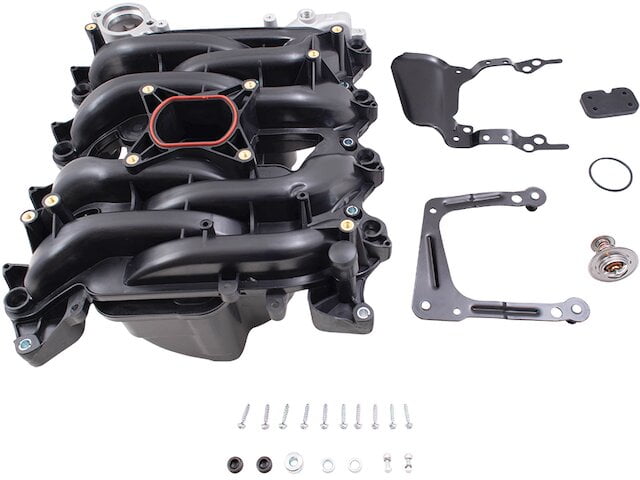2004 Mercury Grand Marquis Intake Manifold

The 2004 Mercury Grand Marquis, a staple of American motoring, is renowned for its comfortable ride, spacious interior, and robust powertrain. A key component contributing to its performance is the intake manifold. This article provides a detailed overview of the 2004 Grand Marquis intake manifold, covering its function, common issues, potential upgrades, and diagnostic tips.
Function and Design
The primary function of the intake manifold is to distribute the air/fuel mixture evenly to each of the engine's cylinders. In the 2004 Grand Marquis, which utilizes the 4.6L Modular V8 engine, the intake manifold is typically constructed from a composite plastic material. This design offers several advantages, including reduced weight compared to cast iron alternatives, and improved thermal insulation, which helps to keep the incoming air cooler. Cooler air is denser, leading to a more efficient combustion process and increased power output.
The 4.6L V8 features a "split-port" induction system. This means the intake manifold has two intake runners per cylinder. One runner is always open, while the second is controlled by Intake Manifold Runner Control (IMRC) valves. These valves open at higher RPMs to increase airflow and boost top-end power. The IMRC system adds complexity but enhances the engine's overall performance across the RPM range.
Common Problems and Symptoms
Despite its robust design, the 2004 Grand Marquis intake manifold is susceptible to certain problems, especially as the vehicle ages. The most common issue is coolant leakage. The composite plastic material can become brittle over time, leading to cracks, particularly around the coolant crossover passages. These passages carry coolant from one cylinder head to the other.
Symptoms of a failing intake manifold can include:
- Coolant loss: Noticeable drop in coolant level without any visible external leaks in other areas.
- Overheating: Due to coolant loss and subsequent air pockets in the cooling system.
- Rough idling: Uneven air distribution can cause misfires and a shaky idle.
- Check engine light: Often accompanied by codes related to lean conditions (too much air), misfires, or coolant leaks. Codes like P0171, P0174, P0300, and P0301-P0308 are frequently associated with intake manifold issues.
- External coolant leak: Pooling of coolant around the front or top of the engine.
The IMRC system can also malfunction. The IMRC valves may stick open or closed due to carbon buildup or actuator failure. This can result in a loss of power, particularly at higher RPMs, and may trigger a check engine light.
Diagnosis and Repair
Diagnosing an intake manifold leak typically involves a visual inspection for coolant leaks, a pressure test of the cooling system, and sometimes, a smoke test to identify hard-to-find leaks. A scan tool can be used to retrieve diagnostic trouble codes (DTCs) that provide clues about the source of the problem.
Replacing the intake manifold is a moderately complex job that requires removing various components, including the throttle body, fuel rails, and associated wiring and hoses. It's crucial to use a new intake manifold gasket to ensure a proper seal. The IMRC valves should also be inspected and cleaned or replaced if necessary.
Torque specifications are critical when reinstalling the intake manifold. Over-tightening the bolts can damage the plastic manifold, while under-tightening can lead to leaks. Consult the vehicle's service manual for the correct torque values and tightening sequence.
Upgrades and Aftermarket Options
While the stock intake manifold is adequate for most driving situations, some owners may consider upgrading to an aftermarket performance manifold. These manifolds often feature improved flow characteristics, which can increase horsepower and torque. However, aftermarket manifolds may require modifications to the fuel system or tuning to optimize performance.
Another option is to replace the stock plastic manifold with an upgraded version featuring improved durability and coolant passage design. These manifolds are designed to address the common coolant leak issue and offer a longer lifespan.
Real-World Use Cases and Examples
Consider this scenario: A 2004 Grand Marquis owner notices their car overheating and the coolant level dropping rapidly. After a visual inspection, they discover coolant pooling around the front of the engine near the intake manifold. A pressure test confirms a leak in the manifold. Replacing the manifold with an upgraded unit addresses the leak and restores proper cooling system function.
Another example involves a loss of power at higher RPMs, accompanied by a check engine light. A mechanic diagnoses a stuck IMRC valve due to carbon buildup. Cleaning the valve restores proper function and resolves the performance issue.
In conclusion, understanding the function, potential problems, and diagnostic procedures related to the 2004 Mercury Grand Marquis intake manifold is crucial for maintaining the vehicle's performance and reliability. Regular inspection and prompt repair of any issues can help prevent more significant problems and keep this classic sedan running smoothly for years to come.
